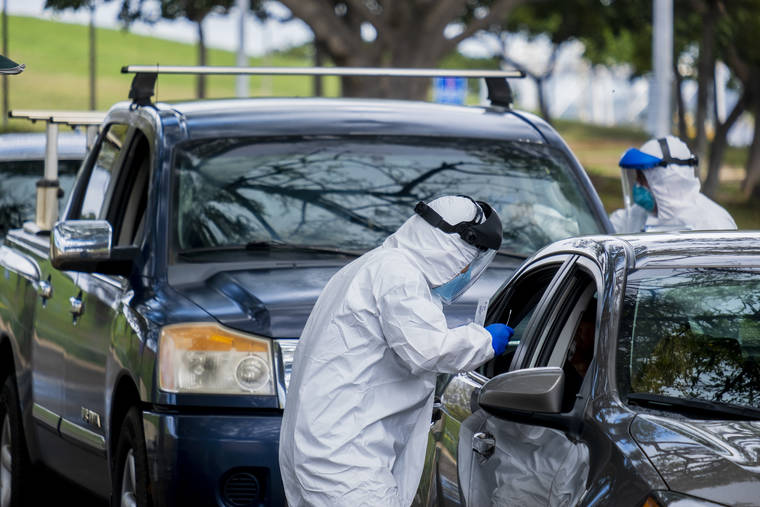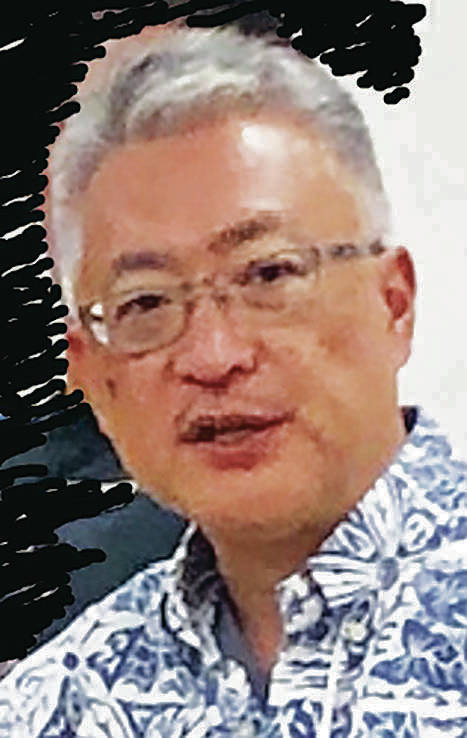Column: More testing! And keep eye on the supplies

DENNIS ODA / 2020
A long line of 100’s of cars line Ala Moana Blvd. and Ward Ave. and snakes their way through Ilalo St. to Cooke St. that leads into Kakaako Waterfront Park to be screened and tested for the coronavirus.

Dr. Seiji Yamada


Is there community transmission in Hawaii of SARS-CoV-2 (the current novel coronavirus)? Yes!
SARS-CoV-2 is very contagious. The infected individuals identified early on had some connection to travel. Both visitors and even locals coming home now have to quarantine. A single case, though, of a person with no connection to travel represents many more people with SARS-CoV-2.
SARS-CoV-2 is very wily. Some die. Some feel completely well but can spread it to others. Of 12 Japanese nationals evacuated from Wuhan who tested positive, five (42%) had no symptoms. The infected person is contagious for two days before the onset of symptoms, and transmissibility peaks before or with the onset of symptoms.
Some 44% of transmission occurs before the infected person develops symptoms. Of the 531 infected individuals evacuated from the Diamond Princess cruise ship, 255 (48%) were asymptomatic at the time of specimen collection.
I have heard some fellow physicians reason, “It doesn’t matter if we don’t identify the minimally symptomatic people, because everybody who is sick is supposed to be isolating.” This doesn’t take into account the need for people to make a living. That person with minor symptoms is going to keep making take-out at the restaurant, cashiering at the grocery store, or caring for kupuna at the nursing home. The public health authorities need to know about every single person infected with SARS-CoV-2.
We need to make sure we can truly isolate each person with the virus, in his/her room, with bathroom, with food and water left outside.
Don't miss out on what's happening!
Stay in touch with breaking news, as it happens, conveniently in your email inbox. It's FREE!
In South Korea, the authorities tracked infected individuals via their cellphones. Sounds like Big Brother, but they flattened their curve.
How do we identify the infected? Of course, we have to test the sick hospitalized patient. But we also have to test people with a bit of cough, with a touch of fever. We can’t afford to test random people without any symptoms — but we should test contacts of the infected. Testing must be performed safely. To collect a sample, one must wear personal protective equipment (PPE), in short supply everywhere. In South Korea, a phone booth-like device was developed with rubber gloves sticking into the booth. The booth is sanitized between patients.
The supply of test kits has improved with the involvement of commercial labs, but we have already seen a shortage of collection swabs. Business people, please get us more! Ingenious people, can you make them?
The point of the two-week quarantine is that those who are going to be sick will get sick within two weeks. If everybody perfectly socially distanced from everybody else for two weeks, no new people would get infected. But obviously, social distancing isn’t going to be perfect, because people belong to families — so we then have to lock down for another two weeks, and then another two weeks.
So we need to know who in particular (i.e., the individual infected with SARS-CoV-2) needs to stay away from everybody else. We can identify those individuals only by testing.
Just maybe, there hasn’t been a lot of community transmission, and those already identified aren’t the tip of an iceberg. Just maybe, we have instituted lockdown in time to keep the numbers low enough for our state Department of Health to track them all down. During the Great Influenza of 1918-1919, Gunnison County, Colo., quarantined itself, barred outsiders from entering, and escaped its ravages. If Hawaii ends up being the Gunnison County of COVID-19, we will owe it to our leaders.
Seiji Yamada, M.D., M.P.H., is a family physician practicing and teaching on Oahu.




